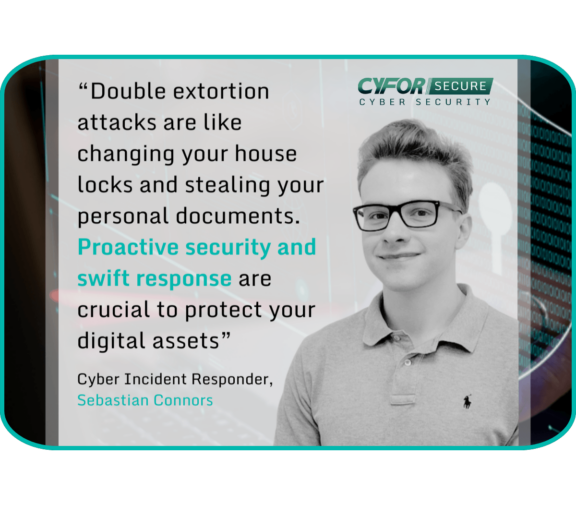The internet is often compared to an iceberg, where the visible portion—the websites indexed by search engines like Google—represents only a small fraction of its entirety. Beneath this surface lies the deep web, which includes private databases and other unindexed content. Within the deep web exists the dark web, a mysterious segment that requires specialised tools to access. No one knows how much of the internet is the ‘dark web’. At CYFOR Secure, we help organisations detect, mitigate, and prevent dark web-related breaches before they escalate. In this blog, we’ll explore what the dark web is, how it’s evolving and targets businesses, rounding off with a brief overview of how CYFOR Secures Dark Web Monitoring solutions keeps businesses secure.

What Is the Dark Web and How to Access It
The dark web is a hidden part of the internet that exists within the deep web, which makes up about 96% to 99% of online content. Unlike the clear web, it is intentionally unindexed, unregulated, and inaccessible through standard browsers. Instead, it requires anonymising software such as the Tor browser to access “. onion” sites, ensuring privacy and anonymity.
To access the dark web, users must download specialised software like Tor (The Onion Router), which routes internet traffic through multiple servers worldwide to mask identities and locations. Once installed, users can explore directories such as The Hidden Wiki or use dark web search engines like Grams. However, navigating the dark web is complex websites frequently change addresses to evade detection or Distributed Denial-of-Service (DDoS) attacks, making the experience chaotic and unreliable. Cyber criminals use the dark web due to the anonymity it offers. It’s almost impossible to track down their locations, and often activities occur over different policing institutions/countries so it’s hard for authorities to collaborate, catch and convict.
What’s on the dark web?
The dark web hosts a variety of illicit and criminal activity. It’s a space for anonymous forums, marketplaces selling illegal goods such as drugs and weapons, hacking services, and stolen information from data breaches. Many sellers on the dark web traffic in illegal drugs, personal information (like passwords and account numbers), and various forms of physical and digital materials across borders. In addition to personal data compromised in cyber-attacks and scams, these black markets provide access to emerging cyber threats, viruses, and even hireable hitmen.
While much of the dark web is associated with criminal activity, it does also host legitimate services. For example, journalists and whistleblowers use it to share sensitive information securely, and privacy-conscious individuals explore encrypted communication tools.
The State of the Dark Web in 2025
With the wide spread adoption of AI, the dark web is evolving faster than ever, enabling cyber-attacks on mass-scale. Our team have seen first-hand how operations on the dark web are becoming far more efficient and organised. Groups like ‘Akira’ are built with a similar infrastructure to ordinary companies, with HR departments, Sales and Client Representatives. For context, mid-way through one ransomware negotiation our team conducted, our client representative from a ransomware group changed, as the original representative our team were negotiating with went on maternity leave. The advancing structure of these criminal groups is due to increased activity, with even the more amateur and less skilled cyber-criminal able to launch highly sophisticated attacks through purchasing ready-to-go-attack-packs on the dark web, called RaaS (Ransomware-as-a-Service).
The development of AI is a key tool enabling the mass automation of cyber-attacks. Key AI-driven attacks that are becoming more mainstream on the dark web, include:

-
- – Deepfake phishing, which has increased by 120% in 2024 (Cyber Security Intelligence).
- – Automated credential stuffing tools, which are also being created and sold as a service on the dark web, are making brute-force attacks faster and harder to detect. Brute Force attacks are when hackers guess the information needed to gain access to an account. The hacker consistently tries to gain access, and with AI, this can be done rapidly at scale.
- – ChatGPT-like AI bots can generate convincing scam emails, lowering the entry barrier for fraudsters, and scaling up attacks.
Further, as mentioned earlier, RaaS attacks are becoming more common, with small and medium-sized businesses (SMBs) being prime targets:

- – There has been a 45% increase in ransomware attacks against UK SMBs (2024 NCSC Report).
- – The average ransom demand now exceeds £250,000, with double-extortion tactics (demanding payment and threatening data leaks). These attacks can end up costing millions.
The constant probing of network security layers, combined with AI, makes it easier to scale attacks and bypass security. Initial Access Brokers sell stolen credentials on the dark web, waiting for the right buyer. A significant percentage of breaches involve compromised credentials, leading to many SMBs shutting down within six months due to financial losses. 71% of breaches in 2024 involved compromised credentials, and 60% of SMBs hit by cyber-attacks shut down within six months due to financial losses.
How CYFOR Secures Dark Web Monitoring Works
At CYFOR, we provide real-time threat intelligence to detect and neutralise risks before they impact your business.
Our Monitoring Process:
We offer continuous dark web scanning. This tracks 800,000+ dark web sites, forums, and marketplaces. It detects any leaked employee credentials, corporate data, and intellectual property. No matter how sophisticated your IT security is, if your credentials have been compromised on the dark web, through things like unused passwords leaking from unused or forgotten accounts, then your business is at risk of cyber threats, and you will require dark web monitoring services.
Our team also offer AI-Powered Threat Analysis. This identifies high-risk exposures (e.g., CEO email credentials, admin logins). It also cross-references breaches with your company domains and third-party vendors, ensuring you have no third-party supplier leaks, that could compromise your whole network.
Further, the team offer actionable alerts & mitigation strategies. Your company will receive immediate notifications when your data appears on the dark web. CYFOR will then recommend steps to reset passwords, enforce MFA, and patch vulnerabilities.
Case Study: Thwarting a Double- Extortion Ransomware Attack

In late 2024, CYFOR Secure thwarted a double extortion ransomware attack after cyber criminals used stolen credentials to infiltrate a client’s systems. The attackers exfiltrated sensitive data and demanded a ransom, but the CYFOR Secure team swiftly blocked their access, identified the stolen data, and took legal action to remove it. This case underscores the importance of dark web monitoring in preventing cyber threats before they escalate.
Read the case here.
How Can Your Business Stay Protected?
You can request a Dark Web Scan. Our team will check if your company’s credentials or data are exposed.
Standard procedure is always to implement multi-layered security:
- – Dark Web Monitoring (Continuous exposure tracking)
- – Zero Trust Architecture (Verify every access request)
- – Employee Awareness Training (Stop phishing & social engineering)
With GDPR, NIS2, and upcoming ransomware law changes, proactive monitoring ensures compliance and reduces legal risks.
Final Thoughts
The dark web isn’t going away—it’s getting more sophisticated. Businesses that rely on passive security are at high risk of breaches, fraud, and financial loss.
CYFOR Secures Dark Web Monitoring provides the early detection and rapid response needed to stay protected. Don’t wait for an attack—take control of your cyber security today.